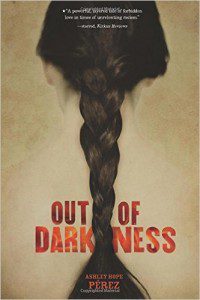 On March 18, 1937, a natural gas leak led to a deadly explosion and collapse of the all-white school in New London, a town in East Texas. Ashley Hope Pérez, who grew up nearby, has mined her grandmother’s recollections, archives, and historical narratives to build a complex and memorable novel around this event, a novel that at its core explores love across hard racial lines.
On March 18, 1937, a natural gas leak led to a deadly explosion and collapse of the all-white school in New London, a town in East Texas. Ashley Hope Pérez, who grew up nearby, has mined her grandmother’s recollections, archives, and historical narratives to build a complex and memorable novel around this event, a novel that at its core explores love across hard racial lines.
Seventeen-year-old Naomi Vargas, now called Naomi Smith, is a misfit in New London – the brown-skinned daughter of Mexican-American parents. After her father drowned shortly after she was born, her mother married a handsome Anglo oil field worker. Henry Smith, though, proved to be a demanding and troubled husband, and when his new wife died after bearing twins Beto and Cari, Henry left the three children with their abuelos in San Antonio. But now sober and an evangelical Christian, he has brought the family to East Texas where they must follow the rules to fit into the white side of a Jim Crow society.
Rule following goes by the wayside when handsome black teenager Wash Fuller (who is not allowed to attend the Consolidated School but goes to the inferior Colored School, with shorter hours, a shorter school year, and castoff supplies) finds Naomi hiding from bullies in a tree and she introduces him to her 7-year-old half-siblings. Beto and Cari enjoy exploring the piney woods and fishing for their supper with Wash, and Naomi faces down her anxiety about sex – the result of Henry’s past abuse – to become intimate with him. But Henry, who has started drinking again, has designs on Naomi, who is now old enough to legally replace her mother in the marital bed. Surprisingly, most of the town, including the pastor and the Smiths’ churchgoing neighbors, think that such a perverse union is acceptable – certainly far more acceptable than a loving, consensual relationship among equals of different races. It is in this volatile racial and sexual mix that the explosion happens.
Pérez’s eloquent third-person omniscient narrative focuses on Naomi, Wash, Beto, Henry, and The Gang, the group of white students who enforce the color line and gossip about Naomi’s beauty and desirability as they stereotype and torment her. Using the third person allows her to comment on her characters whose lives take on the dimensions of a Shakespearean tragedy, and to immerse the reader in a richly drawn setting that is itself a character. As she writes:
They had been happy for a time, before the rules found them. Before the terrible price was exacted for their transgressions. For the crossing of lines. For friendship, for love.
Ultimately, this powerful novel asks: What are we willing to sacrifice for friendship and love? For defying an unjust society? For working to bring about racial justice?
1 comment for “A Tragedy of Race: Out of Darkness”